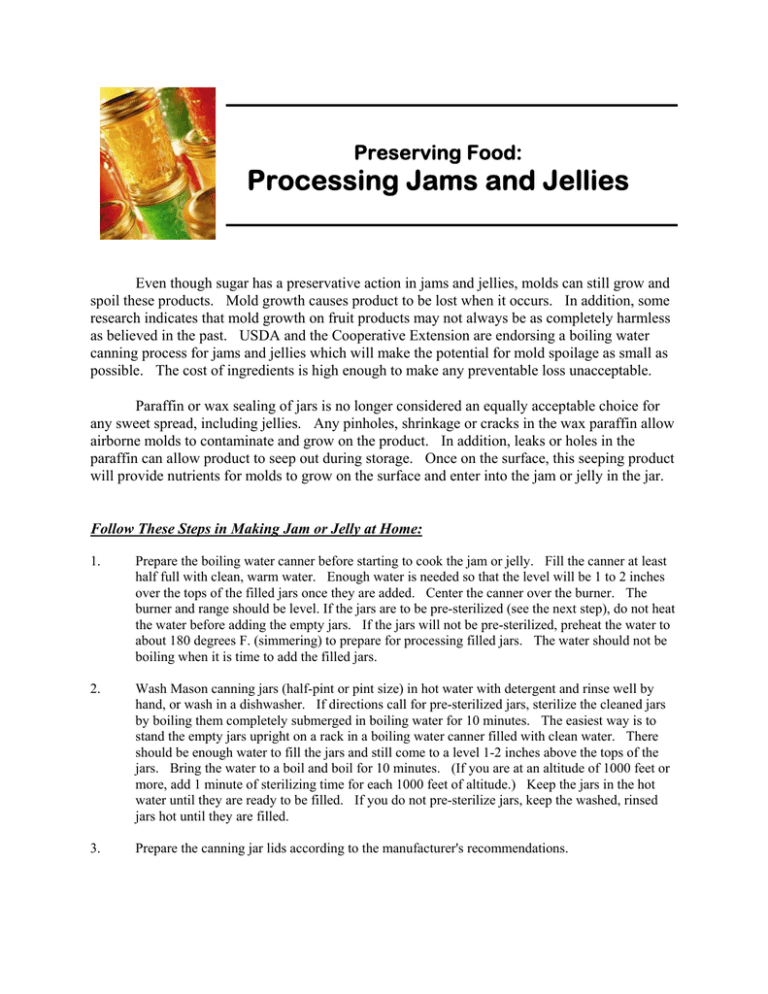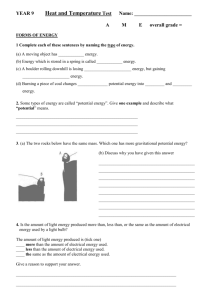Processing Jams and Jellies Preserving Food:
advertisement

Preserving Food: Processing Jams and Jellies Even though sugar has a preservative action in jams and jellies, molds can still grow and spoil these products. Mold growth causes product to be lost when it occurs. In addition, some research indicates that mold growth on fruit products may not always be as completely harmless as believed in the past. USDA and the Cooperative Extension are endorsing a boiling water canning process for jams and jellies which will make the potential for mold spoilage as small as possible. The cost of ingredients is high enough to make any preventable loss unacceptable. Paraffin or wax sealing of jars is no longer considered an equally acceptable choice for any sweet spread, including jellies. Any pinholes, shrinkage or cracks in the wax paraffin allow airborne molds to contaminate and grow on the product. In addition, leaks or holes in the paraffin can allow product to seep out during storage. Once on the surface, this seeping product will provide nutrients for molds to grow on the surface and enter into the jam or jelly in the jar. Follow These Steps in Making Jam or Jelly at Home: 1. Prepare the boiling water canner before starting to cook the jam or jelly. Fill the canner at least half full with clean, warm water. Enough water is needed so that the level will be 1 to 2 inches over the tops of the filled jars once they are added. Center the canner over the burner. The burner and range should be level. If the jars are to be pre-sterilized (see the next step), do not heat the water before adding the empty jars. If the jars will not be pre-sterilized, preheat the water to about 180 degrees F. (simmering) to prepare for processing filled jars. The water should not be boiling when it is time to add the filled jars. 2. Wash Mason canning jars (half-pint or pint size) in hot water with detergent and rinse well by hand, or wash in a dishwasher. If directions call for pre-sterilized jars, sterilize the cleaned jars by boiling them completely submerged in boiling water for 10 minutes. The easiest way is to stand the empty jars upright on a rack in a boiling water canner filled with clean water. There should be enough water to fill the jars and still come to a level 1-2 inches above the tops of the jars. Bring the water to a boil and boil for 10 minutes. (If you are at an altitude of 1000 feet or more, add 1 minute of sterilizing time for each 1000 feet of altitude.) Keep the jars in the hot water until they are ready to be filled. If you do not pre-sterilize jars, keep the washed, rinsed jars hot until they are filled. 3. Prepare the canning jar lids according to the manufacturer's recommendations. 4. Prepare the jam or jelly according to recipe directions. Boil for the recommended time in the recipe and then quickly skim off foam (if needed or desired). 5. Remove pre-sterilized jars from the hot water one at a time, tilting them to quickly empty them into the canner. To make sure they are completely drained, they may be turned upside down on a clean towel on the countertop. Fill either the pre-sterilized or hot, clean jars quickly with the hot jelly or jam mixture, leaving 1/4 inch headspace. Wipe the sealing surface of the jars with a clean paper towel, dampened with hot water, to remove any jelly, jam or sugar crystals. Adjust lids. Work quickly to insure that the filled jars stay as hot as possible until all are filled and ready to load into the canner for processing. However, remember the jam or jelly mixture is very hot and take precautions not to burn yourself. 6. Load the filled jars, fitted with lids, into the canner one at a time, using a jar lifter. Make sure the jar lifter is securely positioned below the neck of the jar and ring band. Keep the jar upright at all times. Tilting the jar could cause the hot jelly or jam mixture to spill into the sealing area of the lid, which should remain clean and undisturbed. The water in the canner can be close to boiling when the jars are added, if you have made sure the filled product has remained very hot until the canner load is ready. 7. Turn the burner under the canner to its highest heat setting, cover the canner with its lid and heat until the water comes to a full boil. If the jars were pre-sterilized, boil the jam or jelly gently for 5 minutes. If hot, clean jars were used, process the jam or jelly for 10 minutes. (If you are at an altitude of 1000 feet or more, add 1 minute of sterilizing time for each 1000 feet of altitude.) The water level in the canner should be 1to 2 inches above the tops of the jars. The water in the canner must remain boiling during the entire 5- or 10- minute process time, so keep a tight lid on the canner. 8. When the jars have been processed in boiling water for the recommended time, turn off the heat and remove the canner lid. Wait 5 minutes before removing jars from the canner to allow the boiling and jar contents to settle. This waiting period is not required for safety of the food, however. 9. Remove jars from canner; use a jar lifter and keep jars upright. Carefully place them directly onto a towel or cake cooling rack, leaving at least one inch of space between the jars during cooling. Avoid placing the jars on a cold surface or in a cold draft. 10. Cool jars upright for 12 to 24 hours while vacuum seal is drawn and the jam or jelly sets up. Let the jars sit undisturbed while they cool. When using the standard two-piece metal canning lid system, do not tighten ring bands on the lids. Also, do not push down on the center of the flat metal lid until the jar is completely cooled. For other lid systems, follow the manufacturer’s directions. 11. Remove ring bands from sealed jars. Put any unsealed jars in the refrigerator and use first. 12. Wash jars and lids to remove all residues. Label and store in a cool, dry place out of direct light. Do I have to pre-sterilize the jars? If the jars are not pre-sterilized, the process time in the boiling water canner is 10 minutes. (At altitudes of 1000 feet or more, add 1 minute of sterilizing time for each 1000 feet of altitude.) Jars should still be washed in hot water with detergent and rinsed well by hand, or washed in a dishwasher, and kept warm until they are ready to be filled. Pre-sterilization of jars (and thus the five minute process time) is preferred when the fruits may not be naturally high in pectin, since the longer process time in the canner without pre-sterilized jars may weaken these gels. Are there other methods of sealing jars? Some other methods of sealing jars call for inverting a closed, filled jar of hot product for anywhere from thirty seconds to one hour. (Inverting is turning the filled jar upside down on its lid.) While this inversion process can be successful in producing a sealed jar, it works best with very hot product. Individual variation in practicing this procedure or unexpected interruptions can result in delays between filling jars, getting lids screwed on, and inverting the jars. If the product cools down too much, the temperature of the product can become low enough to no longer be effective in sealing jars or preventing spoilage. When the inversion process does work, the vacuum seals of filled jars still tend to be weaker than those produced by a short boiling water canning process. A larger amount of retained oxygen in the headspace may allow some mold growth if airborne molds contaminated the surface of the product as the jar was filled and closed. More complete removal of oxygen from the headspace also offers some longer protection from undesirable color and flavor changes with some types of fruit products. A weak seal may be more likely to fail during storage. The canning process is therefore a more foolproof method of making jams and jellies that will not spoil. In addition, although no cases of burning have been reported in the news media, experience has shown that some people will experience leaking of the hot product from the jar when it is turned over if the lid wasn't put on just right. If hot enough, someone could get burned. Even if it doesn’t cause burns, leaking means product is lost. Should I worry about mold? But is there a safety hazard in some molding of a jam or jelly? The best answer is that there is a potential risk. However, we want to make a recommendation that minimizes all potential problems and hazards. Some molds growing on fruit products made at home have been shown to produce "mycotoxins", or mold poisons. The danger to humans from consuming mycotoxins, as well as the actual expected incidence of mycotoxins from moldy jars of jams, are issues with no easy answers. But, animal studies indicate there is the potential for poisonous effects of some mycotoxins in humans. Patulin is one mycotoxin detected in a few tested jars of homemade apple jam and juice. Patulin has been shown to be carcinogenic in animals, but its role in causing human disease is not all that clear. It is also difficult to assess the actual health risk from consuming moldy jam or jelly because not all molds produce mycotoxins, and molds which do produce them vary in consistency of production when conditions change some. Nevertheless, the USDA advice for handling moldy jars of jam or jelly is to discard the contents of the whole jar. (See “Molds on Food: Are They Dangerous,” USDA-FSIS, retrieved June 6, 2011 from http://www.fsis.usda.gov/Fact_Sheets/Molds_On_Food/index.asp and http://www.fsis.usda.gov/PDF/Molds_on_Food.pdf.) Summary Because we are interested in recommending jam and jelly making procedures that offer the highest quality, the least health and safety risks, and the lowest chance of losing product, all Extension recommendations for jams and jellies include a boiling water canning process for room temperature storage of sealed jars. Standard canning jars used with self-sealing flat metal lids and ring bands, pre-sterilization of clean canning jars, hot filling of product into the jars, and processing for 5 minutes in a boiling water canner are recommended for highest quality and to prevent mold growth. ### Elizabeth L. Andress, Ph.D., Professor and Extension Food Safety Specialist The University of Georgia and Ft. Valley State University, the U.S. Department of Agriculture and counties of the state cooperating. The University of Georgia Cooperative Extension and the Colleges of Agricultural and Environmental Sciences & Family and Consumer Sciences offer educational programs, assistance and materials to all people without regard to race, color, national origin, age, sex or disability. An Equal Opportunity Employer/Affirmative Action Organization Committed to a Diverse Work Force FDNS-E-37-1 Revised June 2011





